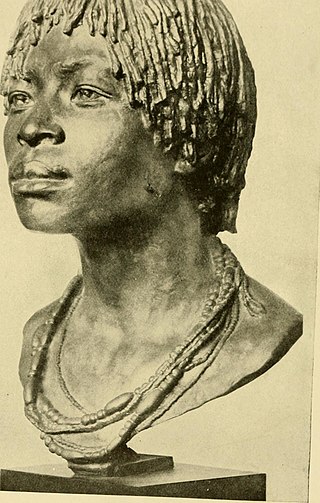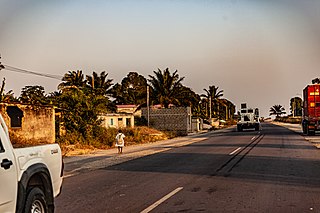Related Research Articles

The Kongo people are a Bantu ethnic group primarily defined as the speakers of Kikongo. Subgroups include the Beembe, Bwende, Vili, Sundi, Yombe, Dondo, Lari, and others.
The pre-colonial history of the modern-day Democratic Republic of the Congo encompasses the history of the Congo Basin region up to the establishment of European colonial rule in the era of New Imperialism and particularly the creation of the Congo Free State and its expansion into the interior after 1885. As the modern territorial boundaries of the Democratic Republic of the Congo did not exist in this period, it is inseparable from the wider pre-colonial histories of Central Africa, the Great Lakes and Rift Valley as well as the Atlantic World and Swahili coast.

Pedro V Elelo was king of Kongo from 7 August 1859 to February 1891. His base was in the district of Madimba, which lay south of the capital and was in the lands held by the ancient southern branch of the Kinlaza lineage called Kivuzi.

Álvaro I Nimi a Lukeni lua Mvemba was a Manikongo, or king of Kongo, from 1568 to 1587, and the founder of the Kwilu dynasty.

Ngoyo was a kingdom of the Woyo ethnic group, located in the south of Cabinda. Located on the Atlantic coast of Central Africa, just north of the Congo River, it was founded by Bantu-speaking people around the 15th century. Ngoyo tradition held that the kingdom's ancestors were among the earliest settlers in the area, leading their chiefs to title themselves the nfumu nsi. The capital was Mbanza Ngoyo.

The Kingdom of Kongo was a kingdom in Central Africa. It was located in present-day northern Angola, the western portion of the Democratic Republic of the Congo, Southern of Gabon and the Republic of the Congo. At its greatest extent it reached from the Atlantic Ocean in the west to the Kwango River in the east, and from the Congo River in the north to the Kwanza River in the south. The kingdom consisted of several core provinces ruled by the Manikongo, the Portuguese version of the Kongo title Mwene Kongo, meaning "lord or ruler of the Kongo kingdom", but its sphere of influence extended to neighboring kingdoms, such as Ngoyo, Kakongo, Loango, Ndongo, and Matamba, the latter two located in what is Angola today.

Kwilu, also known as the House of Kwilu, was a kanda or royal lineage of the Kingdom of Kongo.

Soyo is a city, with a population of 200,920, and a municipality, with a population of 227,175, located in the province of Zaire in Angola, at the mouth of the Congo river. Historically, Soyo was a significant city in conflicts between the Kingdom of Kongo, Portuguese Angola, and the Dutch West India Company. Soyo became an independent state in the 17th century and had significant influence on politics in Kongo during the Kongo Civil War.

Garcia II Nkanga a Lukeni a Nzenze a Ntumba, also known as Garcia Afonso for short, ruled the Kingdom of Kongo from 23 January 1641 to 1661. He is sometimes considered Kongo's greatest king for his religious piety and his near expulsion of the Portuguese from Angola. Yet, he is also notorious for enriching himself through his leading role in the Atlantic slave trade.
Nsundi was a province of the old Kingdom of Kongo. Its capital was located on the Inkisi River, near the present-day village of Mbanza Nsundi in Democratic Republic of Congo.

The Kinlaza were members of the Nlaza kanda or House of Kinlaza, one of the ruling houses of the Kingdom of Kongo during the 17th century. It was one of the main factions during the Kongo Civil War along with the Kimpanzu and Kinkanga a Mvika kandas. They are remembered in tradition and are evoked in a proverb, still current in the 1920s Nkutama a mvila za makanda "Kinkanga, Kimpanzu ye Kinlaza makukwa matatu malambila Kongo".

Mvemba a Nzinga, Nzinga Mbemba, Funsu Nzinga Mvemba or Dom Alfonso, also known as King Afonso I, was the sixth ruler of the Kingdom of Kongo from the Lukeni kanda dynasty and ruled in the first half of the 16th century. He reigned over the Kongo Empire from 1509 to late 1542 or 1543.

Lukeni lua Nimi was the traditional founder of the Lukeni kanda dynasty, first king of Kongo and founder of the Kingdom of Kongo Dia Ntotila. The name Nimi a Lukeni appeared in later oral traditions and some modern historians, notably Jean Cuvelier, popularized it. He conquered the kingdom of Mwene.

Pedro II Nkanga a Mvika was a ruler of the kingdom of Kongo during the kingdom's first conflict with the Portuguese. He was the founder of the royal House of Nsundi and could trace his descent to one of Afonso I's daughters. He was succeeded by his son Garcia I, who was crowned in 1624.
The Kongo Civil War (1665–1709) was a war of succession between rival houses of the Kingdom of Kongo. The war waged throughout the middle of the 17th and 18th centuries pitting partisans of the House of Kinlaza against the House of Kimpanzu. Numerous other factions entered the fray claiming descent from one or both of the main parties such as the Água Rosada of Kibangu and the da Silva of Soyo. By the end of the war, Kongo's vaunted capital had been destroyed and many Bakongo were sold into the Trans-Atlantic Slave Trade.

M'banza-Kongo, is the capital of Angola's northwestern Zaire Province with a population of 148,000 in 2014. M'banza Kongo was the capital of the Kingdom of Kongo since its foundation before the arrival of the Portuguese in 1483 until the abolition of the kingdom in 1915, aside from a brief period of abandonment during civil wars in the 17th century. In 2017, M'banza Kongo was declared a UNESCO World Heritage Site.
Henrique II was ruler of the Kingdom of Kongo. His rule came after the end of a period of conflict in the kingdom after the death of Afonso V, who was said to have been poisoned. Henrique was able to take the throne as a compromise between the various powerful factions which had been brokered by the Água Rosada house, the descendants of Pedro IV, who had familial ties to branches of both Kinlaza and Kimpanzu houses. Under this peace, Henrique was able to rebuild the nation, and eventually passed the throne on to Garcia V, a member of the Água Rosada house.
Afonso V of the Congo was a Kinlaza manikongo of the Kingdom of Kongo from 1785 to 1787. He succeeded to his brother José I of Kongo without any struggle in April 1785 and was part of the southern faction of the Kanda Kinzala based in Nkondo. He was a king known for his piety and took the pompous title of the powerful Dom Alfonso V, King of Congo, ruler of part of Ethiopia in his letters. It is possible he was poisoned by his successor in order to seize the throne. His sudden death caused a period of turmoil within the nation that would not end until Henrique II took the throne.
Pedro V Ntivila a Nkanga was a ruler of the throne of the Kingdom of Kongo and a member of the Kimpanzu house. He ruled Kongo from 1763 to 1764, after he overthrew Sebastião I, when Pedro refused to relinquish the Kimpanzu claims to the throne. This overthrow resulted in the breakdown of the rotating houses system put in place by Pedro IV. His reign was short-lived, however, and after he was in turn overthrown by Álvaro XI, he was removed from the official records, evidenced by the ascension of the official Pedro V in 1859. It is most likely due to the fact that he claimed the throne at the same time as Álvaro IX, though he kept his claim on the throne even after his removal.
References
- ↑ "Kingdoms of Africa - Angola / Kongo Kingdom".
- ↑ Thronton, John. 2000. “Mbanza Kongo/Sao Salvador: Kongo's Holy City” in Africa's Urban Past (eds.) David Anderson and Richard Rathbone. Oxford: James Currey Ltd. Page 76
- ↑ Kwame Anthony Appiah (2005). Africana: The Encyclopedia of the African and African American Experience. Oxford University Press. p. 2. ISBN 978-0-19-517055-9.
- ↑ John K. Thornton. A History of West Central Africa to 1850. Cambridge University Press, 2020. p. 344
- ↑ Thornton. West Central Africa to 1850, p. 344
- ↑ Thornton. West Central Africa to 1850, p. 344
- ↑ Thornton. A History of West Central Africa to 1850, p. 344